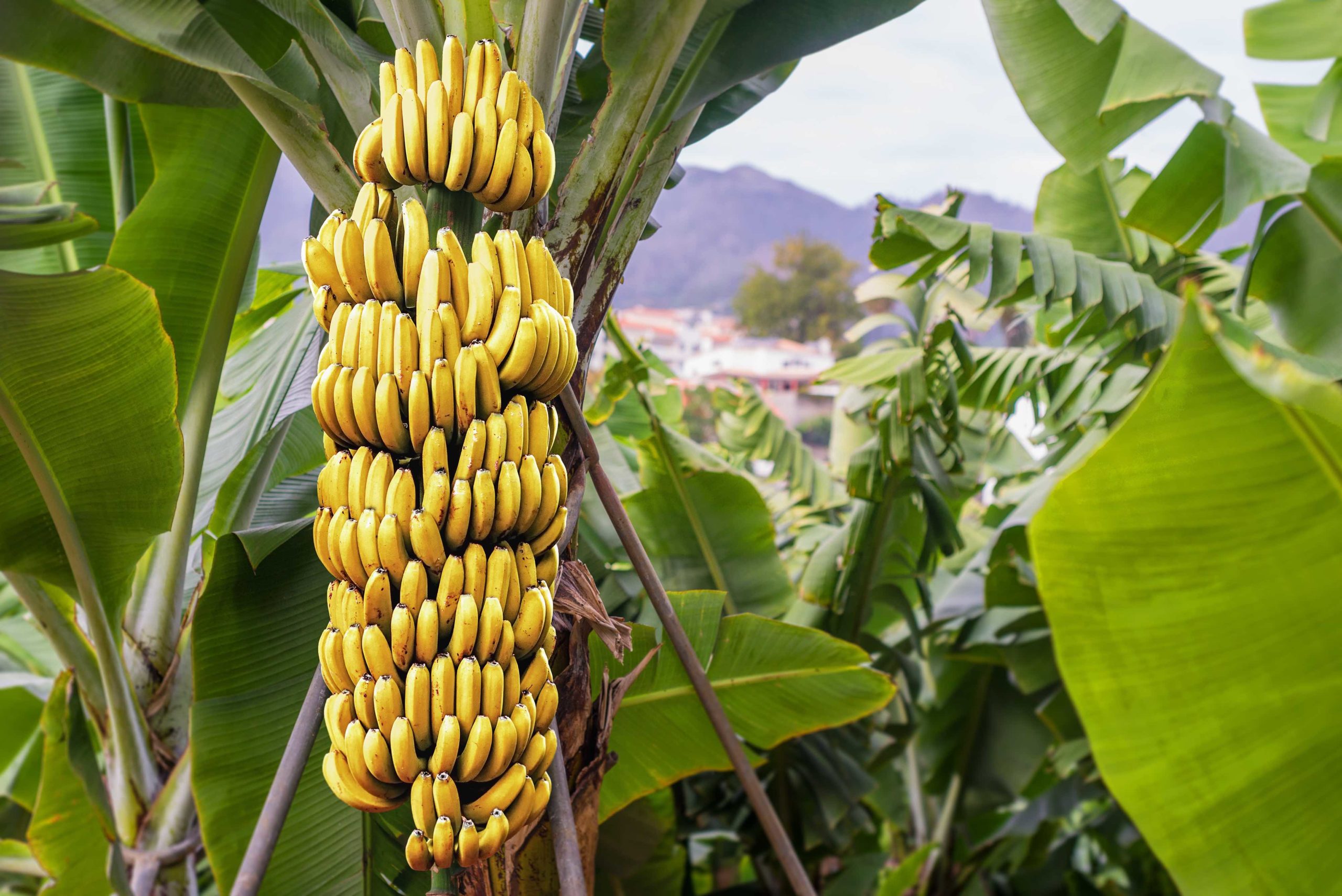47% of the global banana production is in danger. The Cavendish banana, which makes up 99% of the global banana export, is being threatened by the Panama disease. This devastating disease, also known as Fusarium wilt, is caused by the fungal pathogen Fusarium oxysporum f. sp. cubense Tropical race 4 (Foc TR4). FungiAlert can quickly identify the presence or absence of Fusarium oxysporum f. sp. cubense providing a method that can be extremely helpful to stop the spread of the inoculum in banana plantations before it becomes too late.
According to the Food and Agriculture Organisation, virtually all the bananas consumed in Europe and the US are Cavendish bananas. The Cavendish banana variety has monopolised global banana production since the 1950s. This monopoly over the 1,000 existing different banana varieties is due to the resistance that the Cavendish banana had to a fungal disease that wiped out its predecessor, the Gros Michel banana variety. Since the Cavendish and the Gros Michel banana require similar farming conditions, the resistant Cavendish banana became the world’s most popular banana. Today, global banana production amounts to 50 billion tonnes and Ecuador is the main exporter, being responsible for one-third of global banana exports between 2014 to 2018.
Unsurprisingly, the monoculture of a single banana variety has led to the eco-disaster that the Cavendish banana is facing today. In simple agricultural ecosystems (such as in monoculture), the arms-race between plant host and pathogen enforces an intense natural selection fight. This fight is usually won by the adaptation of the most genetic diverse party, generally the plant pathogen. Today, the Cavendish banana is in huge disadvantage in the arms-race against Foc TR4 or the Panama disease.
So, where does this nasty Fusarium oxysporum f.sp cubense come from?
The fungal species Fusarium oxysporum f.sp cubense is classified in four races based on the host range of cultivars on which they can cause disease. Race 1 was responsible for the destruction of the Gros Michel banana cultivars in the mid 20th century. Race 4 was initially known to cause Fusarium wilt in Cavendish cultivars in subtropical areas. However, in the 1990s, Cavendish cultivars in Southeast Asia succumbed to Fusarium wilt and the fungus responsible was then named Tropical race 4. (Source: article “The Movement of Fusarium oxysporum f.sp. cubense (Sub-Tropical Race 4) in Susceptible Cultivars of Banana”. Noeleen M. Warman and Elizabeth A. B. Aitken, Frontiers in Plant Science, 2018). Fusarium oxysporum f.sp cubense TR4 quickly spread from Southeast Asia to Africa and Western Asia, then to Australia and the Middle East. Earlier this year, Fusarium oxysporum f.sp cubense TR4 was detected in Latin America, threatening the biggest exporter of bananas in the world.
Panama disease or Fusarium wilt of banana is a vascular wilt disease. The fungus Fusarium oxysporum f.sp cubense infects the roots of susceptible banana plants. In the xylem of resistant plants compounds are produced to respond early to the infection and stop the colonisation of the plant by the fungus. However, susceptible cultivars do not produce these compounds in time. Hence, susceptible banana plants cannot fight the fungus and promptly succumb to systemic infection. The old leaves of infected plants wilt and die, collapsing against the pseudostem. Then, younger and younger leaves develop symptoms, until the plant eventually collapses. Due to the fungal colonisation of the plant, its xylem becomes reddish brown and the nutrient transport is impaired causing the death of the plant. (Reference: “Fusarium Wilt of Banana, Randy C. Ploetz, Phytopathology, 2015”).
What can be done to stop the spread of Foc TR4?
Unfortunately, to date there is no effective chemical or biological solution to eradicate the fungus from infested soils. This fungus can survive as chalmydospores in the soil for over 20 years. But F. oxysporum f. sp. cubense is a necrotrophic or hemobiotrophic pathogen, meaning that in a part of its life cycle it will colonise a host plant. Therefore, it is possible that long-term survival of the inoculum could be promoted through the infection of weeds (Reference: “Fusarium Wilt of Banana: Current Knowledge on Epidemiology and Research Needs Toward Sustainable Disease Management”; Dita M, Barquero M, Heck D, Mizubuti ESG and Staver CP, Front. Plant Sci., 2018). Dispersal of the pathogen occurs by passive movement of the pathogen inoculum, long distance dispersal generally occurs due to human intervention, and short distance dispersal can be due to human or natural factors that leads to soil movement (i.e. water runoff, animal movement, or spore-bearing-soil movement).
So, if there is no effective control to date for stopping the Panama disease, what measure can be taken to reduce the chance of disease outbreaks?
It has been demonstrated that infected mother plants can transmit the infection to the suckers, which can remain symptomless during a latent period of the disease. Therefore, it is crucial to carefully control the movement of plant parts used in plantations and verify the health of propagation material. FungiAlert can quickly identify the presence or absence of Fusarium oxysporum f. sp. cubense from plant material. These analyses can be extremely helpful to stop the spread of the inoculum in banana plantations before it becomes too late.
Water is another very common vector used by Fusarium oxysporum f. sp. cubense to colonise new territories. In fact, the rapid spread of Foc TR4 in China was associated to plant propagation material and the irrigation water that came from Pearl River (Xu, L. B., Huang, B. Z., and Wei, Y. R.; “Production and banana RandD in China,” Los Baños, 2003). A timely detection of Foc TR4 in irrigation sources is vital to avoid catastrophic outbreaks in banana plantations. Fortunately, FungiAlert has developed an effective method to detect fungal diseases in irrigation sources. The SporSenZ can be used to monitor the health of the water and to confirm the absence of inoculum.
Commonly, the dispersal of Foc in soil comes from vectors of soil movement, such as roots or debris from infected plants, water, wind, animals, tools, machinery tires, visitors’ shoes and other sources carrying particles of soil. Controlling the movement of soil particles becomes almost an impossible task. Therefore, it is essential to monitor the absence of inoculum of Foc in the soil of clean plantations. FungiAlert’s soil health analyses are unique because they can detect alive sources of inoculum in the soil before visual symptoms are detected. This rapid alert of the presence of Foc in a clean plantation is key for taking actions that will minimise the impact of the disease.
Is the war Foc against Cavendish lost?
No, there is hope coming from the soil biodiversity! Studies have documented the existence of suppressive soils, which are soils where the impact of the disease is minimal or null, regardless of the presence of the pathogen and susceptible hosts. Some research groups have found that there is more diversity in the microbial community in suppressive soils to Panama Disease than in conductive soils. This implies that if banana growers were able to measure the diversity of the soil microbial community before planting our beloved susceptible Cavendish banana, then the spread of disease could be controlled and therefore minimised. FungiAlert’s soil biology analysis facilitated by the SporSenZ is a key tool for minimising disease loss in banana plantations. Unlike other soil microbiology analysis, the SporSenZ will ensure that only alive microorganisms in the soil will be detected. That is why FungiAlert’s analyses are the only ones that can truly indicate if there are active microbes in the soil that can stop the spread of Foc TR4.
Tissue culture propagation of this plant can provide Foc-free banana plantlets. However, these plantlets have shown to be more susceptible to the Panama disease. It has been suggested that this is due to the fact that plants propagated by tissue culture lack all the beneficial microbes that come from the soil. These beneficial microbes, like it happens in our guts, protect the roots from infection. A holistic solution would be to identify these beneficial microbes that protect the roots from infection and inoculate the plants before planting them. However, first we need to identify those good microbes that stop the villain Foc from infecting the plant. Then, we need to make sure that we find the appropriate method to inoculate the roots of tissue-culture propagated material. Finally, we need to ensure that the inoculation has been successful. At FungiAlert we are willing to find the right partner to be able to investigate this. With a team of 5 PhDs in plant pathology, microbiology and molecular genetics, we believe that FungiAlert can deliver the knowledge and expertise that will help fight the nasty Foc TR4, due to our unique SporSenZ technology.
Last comments…
A group of researchers have put together a very comprehensive review about the current knowledge of fusarium wilt in banana (“Fusarium Wilt of Banana: Current Knowledge on Epidemiology and Research Needs Toward Sustainable Disease Management”; Dita M, Barquero M, Heck D, Mizubuti ESG and Staver CP, Front. Plant Sci. 9:1468, 2018). They believed that if rapid and efficient tools were available to detect the different strains of Foc TR4, the biosecurity and quarantine measures will greatly improve. That is why FungiAlert is proposing their laboratory and services to help solving this eco-disaster, because FungiAlert has a unique rapid and efficient tool that is able to detect and classify the different strains of Foc TR4.
This review also describes some soil management and IPM strategies that have shown to reduce the incidence of disease. Even though to date there is not a single strategy that has been shown to effectively eradicate the disease, with new tools that can provide information about the real microbial activity in the soil, achieving the goal of finding an effective way of managing Panama disease is now closer than ever!
Ángela de Manzanos
FungiAlert’s CTO
September 2019
More information can be found in this link.


